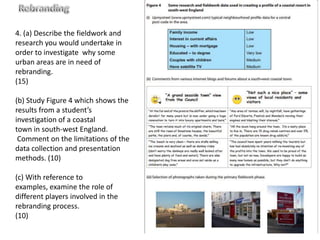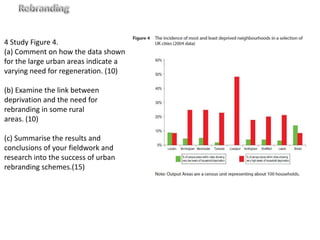Rebranding past papers
- 1. 4. (a) Describe the fieldwork and research you would undertake in order to investigate why some urban areas are in need of rebranding. (15) (b) Study Figure 4 which shows the results from a studentâs investigation of a coastal town in south-west England. Comment on the limitations of the data collection and presentation methods. (10) (c) With reference to examples, examine the role of different players involved in the rebranding process. (10)
- 5. 4 Study Figure 4. (a) What evidence is there to suggest that Wem needs rebranding? (10) (b) Describe the fieldwork and research you would undertake to collect evidence of rebranding in a named urban area.(15) (c) Using examples, examine the success of rural rebranding schemes. (10)
- 9. 4 Study Figure 4. (a) Suggest how the information shows that some seaside towns are in greater need of rebranding. (10) (b) Describe how some places have used sport and leisure as a catalyst to âkick-startâ rebranding. (10) (c) Describe the fieldwork and research you would undertake in order to examine the success of rebranding solutions in an urban or rural area. (15)
- 13. 4 Study Figure 4. (a) Comment on how the data shown for the large urban areas indicate a varying need for regeneration. (10) (b) Examine the link between deprivation and the need for rebranding in some rural areas. (10) (c) Summarise the results and conclusions of your fieldwork and research into the success of urban rebranding schemes.(15)
- 17. 4 Study Figures 4a and 4b. (a) Suggest how the photos provide evidence that this former industrial area has been rebranded. (10) (b) With reference to examples, discuss the role of the players involved in rebranding. (10) (c) For either urban or rural areas, describe the results and conclusions of your fieldwork and research into the success of rebranding schemes. (15)
- 21. 4 Study Figure 4. (a) Choose two strategies and comment on how they could contribute to rural rebranding. (10) (b) For either a rural or urban area, describe the methods you used to collect and present your fieldwork and research into rebranding. (15) (c) Using examples, explain why rebranding strategies are not always entirely successful. (10)
- 25. 4 Study Figure 4. (a) Comment on how the rebranding process sometimes creates conflicts between different groups of people.(10) (b) Using examples, suggest how some places have used rebranding to become more sustainable. (10) (c) For either an urban or a rural area, describe the fieldwork and research you undertook to examine the success of rebranding schemes. (15)
- 29. 4 Study Figure 4. (a) Using Figure 4, suggest why rural rebranding often involves a wide range of players. (10) (b) Using examples, outline the ways in which urban areas have re- imaged themselves to attract more visitors. (10) (c) For either an urban or a rural area, describe the fieldwork and research you undertook to investigate the need for rebranding. (15)
- 33. 4 Study Figure 4. (a) Comment on the usefulness of the three fieldwork approaches to investigate rural rebranding. (10) (b) Using examples, explain how environmental and economic decline have led to the need to rebrand urban areas. (10) (c) For either an urban or rural area, describe the results of your fieldwork and research to investigate the success of rebranding schemes. (15)



































